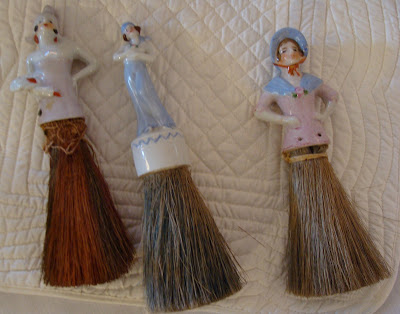Half-Dolls - February 13, 2011 Meeting at Debra's (Thanks for the informative program, Debra!)
Half-dolls are sometimes called half-dolls, pincushion dolls, pincushion figures, half-figures and other names. They were usually attached to items that served a utilitarian purpose, such as pincushiions, tea cozies, lamps, whisk brooms, powder puffs, powder boxes, and perfume bottles. While we can sometimes find the dolls still attached to their original item, many times we can only imagine their original purpose.
Half-dolls offer many positives to a doll collector. They are small and therefore require limited space and are easy to display. Common ones are easily found and are reasonably priced compared to other types of dolls. The more elaborate and rare models are more expensive, but they are quite a beautiful addition to any doll collection.
Half-dolls are classified into three basic types denoted by A, B, and C.
A. Dolls with arms molded into the body in one piece. They were easy and inexpensive to make, do not break easily, and therefore are the least expensive.
B. Half-dolls with arms extending away from the body and the hands returning to touch the body. This adds some support in the arms to prevent breaking.
C. Half-dolls with arms extending away from the body entirely. Theyt generally are very graceful and fragile. These are the most expensive.
Many half-dolls were modeled on famous historical ladies. Marie Antoinette, Jenny Lind, a Swedish singer, and Mrs. Siddons, a British actress, are some of the womenh that were featured. While not as common as the ladies, some half-dolls represented children, babies, male Pierrot, and female Pierrette. Other rare models include those with mohair wigs and those with moveable arms.
Many porcelain factories made half-dolls. Dressel, Kister & Co., F. & W. Goebel, Hertwig & Col, Carl Schneider, and Weiss, Kuhnert & Co. are a few that are known to have manufactured half-dolls. Some dolls have a specific maker's mark and many have only a mold number and "Germany."





No comments:
Post a Comment